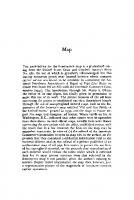Shock or Water Ram in Pipe Lines with Imperfect Reflection at the Discharge End and Including the Ef
258 92 305KB
English Pages 2
Recommend Papers
File loading please wait...
Citation preview
VoL. 6, I1920
ENGINEERING: W. F. D URAND
44I
However, too much faith cannot be placed on intercepts taken so near the origin, with small deflections. 1 Thomson, J. J., London Phil. Mag., Sept., 1915. 2 Rutherford, E., Proc. Cambridge Phil. Soc., 9, 1898 (401). I Franck, J., Verh. Deuts. Phys. Ges., 12, 1910 (613). 4 Wellisch, E. M., Phil. Mag., 34, 1917 (199); also New Haven, Amer. J. Sci., July, 1917. 6 Haines, W. B., Phil. Mag., Oct., 1915; also July, 1916. 6 Thomson, J. J., Rays of Positive Electricity, Monographs on Physics, Longmans, Green & Co., 1913. 7 Bohr, N., Meddelanden fran k. Vetenskapsakademiens Nobel Institute, 5, 1919, No. 28.
SHOCK OR WATER RAM IN PIPE LINES WITH IMPERFECT REFLECTION AT THE DISCHARGE END AND INCLUDING THE EFFECTS OF FRICTION AND NON-UNIFORM CHANGE OF VALVE OPENING By W. F. DURAND LLAND STANFORD JR. UNIVERSITY
Read before the Academy, April 27, 1920
The classic treatment of the problem of shock in pipe conduits, as developed by Joukovsky, Allievi and others, assimilates in effect the condition of the water in the pipe line during the manifestation of the phenomena in question to that of a column of air in a closed organ pipe in longitudinal vibration, the reservoir end of the line corresponding to the mouth end of the pipe and the valve end of the line to the closed end of the pipe. On this basis the theory has been developed in some detail, especially by Allievi. In the treatment thus developed and in subsequent study of the problem generally, it has been common to omit the following factors, the existence of which must affect the result in actual cases: (1) The influence of the velocity head v2/2g. (2) The influence of friction. (3) The loss of energy through the discharge valve considered as a nozzle. (4) The influence due to a time rate of valve area closure irregular, or other than uniform. (5) The influence due to the fact that the valve end of the line is not closed completely so long as the valve is partly open (as in the operation of opening or closing). The analogy with the air in a closed organ pipe is, therefore, imperfect and in particular the reflection at this end must, under these conditions, be incomplete rather than complete, as commonly assumed.
442
REPORT OF THE ANNUAL MEETING
PROC. N. A. SO
The paper discusses the effect of the neglect of these conditions and a more general treatment, as an extension of the original treatment by Joukovsky, is then developed for taking care of conditions (1), (2), (3), (4). Based on this treatment a further extension is then developed, including the influence due to imperfect reflection at the valve end. Four different bases for the specification of the amount of reflection realized are presented and the treatment is developed to include any of these according to choice. These four methods are as follows: (1) A constant fraction or percentage of complete reflection. (2) A fraction or percentage of complete reflection defined as (al- a)la, where a, = area of full valve opening and a = area of opening at any instant during valve movement. (3) A fraction or percentage of complete reflection defined as (A - a)/A where A = cross-section area of pipe and a = area of valve opening at any instant during valve movement. (4) A fraction or percentage of complete reflection defined as (vi - v) /vi where for closure v, = full initial velocity and for opening v1 full final velocity, while v = velocity at any instant during valve movement. The treatment throughout the paper includes both closure and opening of the valve, either in whole or in part, or in general any amount of valve movement either in closure or opening. The paper is illustrated with diagrams showing typical numerical cases. Of the various conditions thus brought within the scope of a form of analytical treatment, the author considers that part of the paper relating to No. 5 of more especial interest, representing, so far as he is aware, a distinct extension of earlier treatments of the problem and in such manner as to bring under some form of analytical control an important condition which must always prevail in actual cases of the development of shock or water ram in liquid conduits.
REPORT OF THE ANNUAL MEETING PREPARED BY THE HOME SECRETARY The annual meeting of the Academy was held in Washington, April 26, 27 and 28, 1920, at the Smithsonian Institution. The following eighty-eight members were present: C. G. ABBOT, BAILEY, A. GRAHAM BELL, BOAs, BOGERT, BRIDGMAN, BUMSTEAD, W. W. CAMPBELL, CARTY, CASTLE, CATTELL, F. W. CLARKE, J. M. CLARKE, CONKLIN, CREW, CROSS, CURTIS, DALL, DAVENPORT, DAVIS, DAY, DICKSON, DONALDSON, DUNN, DURAND, FEWKES, FORBES, FROST, GOMBERG, HALE, E. H. HALL, G. S. HALL, HALSTED, HARPER, HARRISON, HENDERSON, HILLEBRAND, HOLMES, HOWARD, HOWE, HOWELL, IDDINGS, JENNINGS, JEWETT, KAS,


![History, Democracy, Values. New Lines of Reflection: New Lines of Reflection [1 ed.]
9782869784055, 9782869782587](https://ebin.pub/img/200x200/history-democracy-values-new-lines-of-reflection-new-lines-of-reflection-1nbsped-9782869784055-9782869782587.jpg)






![Behind the Lines : Creative Writing with Offenders and People at Risk [1 ed.]
9781908162120, 9781904380788](https://ebin.pub/img/200x200/behind-the-lines-creative-writing-with-offenders-and-people-at-risk-1nbsped-9781908162120-9781904380788.jpg)
